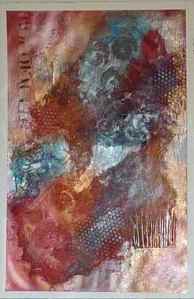Archive for February 2010
Venturing Into The Unknown
Posted on: February 21, 2010
This painting thing is NOT a 9 to 5 job; it’s much harder. I had a “style” when I was very ill, dictated by the amount of time I could sit up, and by a roller-coaster of emotions that flowed out onto the page.
That structure/impetus is gone, and I have to push myself into heaven knows what. It’s terrifying, frankly — and I have no desire to see what others are doing or what is popular. I am trying many different things under the sun, and I have no idea when or if I will “land” on something that feels like mine. I’ll stare at what I’ve done, and know that I have to push it further; I’m not satisfied. But pushing it is risky. For every painting that is “OK”, there are 5 more in the trash. This is when I really regret the lost 20 years.
It’s actually time to submit an application to be in the August 2010 art fair here, and no way am I able to do that. I can’t present myself to the public with a bit of this and a bit of that.
But I can show them to you:-)
Since acrylic is just another form of plastic, pouring it down your drains is a no-no; yet many painters do it. Here are two easy things to do that will make a difference.
First, use a few plates (disposable or not is up to you) as palettes, rotating them when you need a cleaner surface. But the real trick is to paint white over them at the end of a painting session, so that you can keep using them again and again.
You can also use freezer paper from the grocery store (or the art store freezer paper palettes if you’re flush), and after a few layers of paint have built up, the acrylic will just peel off. You can either throw this in the garbage or cut it up and use it as collage elements in another painting.
By far the worst problem is pouring our brush-cleaning jars of water + acrylic down the drain. Bad for the plumbing; bad for the environment. I leave the jars overnight so the paint solids settle to the bottom, then drain off the water in the morning, and pour the solids plus a bit of the water that’s left into a 5-gallon bucket (I use a huge kitty litter bucket w a handle but many building supplies come in these buckets) and when it’s full, I put it near the heat vent so the water will evaporate off.. In the summer, I put it out in the sun (altho you have to keep an eye out for rain). When the water is gone, the paint will peel right out if it’s a plastic bucket.
Of course you need a second bucket to use while the first one is evaporating:-) But these little effort are really worth it to keep our painting passion more earth-friendly.
I’d be interested in any other ideas you acrylic painters out there have for “green” painting. Please share!














